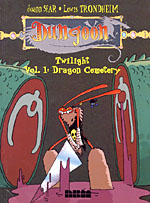 Written by Lewis Trondheim and Joann Sfar
Written by Lewis Trondheim and Joann Sfar
Art by Joann Sfar and Kerascoet
96 pages, color
Published by NBM
Up until now, reading Lewis Trondheim and Joann Sfar’s Dungeon books has been nothing but a great deal of fun. Their “present day” Dungeon Zenith is a wonderful parody of sword and sorcery stories while still having a strong backbone of its own, and the “prequel” Dungeon Early Years installments have been an entertaining mix of intrigue and swashbuckling. Now that we’re seeing the “in the future” books of Dungeon Twilight, we’re getting something slightly different. The series is still full of the brilliant and over-the-top ideas, and it holds the reader’s interest just as tightly. The big difference is that if I had to sum up Dungeon Twilight in one word, it would probably be “bleak.”
 In the future of the world of Terra Amata, things have gone badly. The Great Khan has stopped the planet from spinning, supposedly in an attempt to save it. Those who still survive in what’s left of the world are under his rule, and darkness covers the land. The great Dust King lives as a prisoner of the Khan even as his only wish is to able to journey in private to the hidden Dragon’s Graveyard and die. If he does try to escape, though, it will be just the beginning of a series of events that will change Terra Amata yet again—and probably not for the better.
In the future of the world of Terra Amata, things have gone badly. The Great Khan has stopped the planet from spinning, supposedly in an attempt to save it. Those who still survive in what’s left of the world are under his rule, and darkness covers the land. The great Dust King lives as a prisoner of the Khan even as his only wish is to able to journey in private to the hidden Dragon’s Graveyard and die. If he does try to escape, though, it will be just the beginning of a series of events that will change Terra Amata yet again—and probably not for the better.
Trondheim and Sfar’s writing in Dungeon Twilight (the first four volumes of which are collected into two books for the English-language edition) is bordering on the edge of depressing, especially in what was the original first volume of this storyline. Our main character is a physically ailing protagonist from the earlier series who genuinely wants nothing more than to end his own existence. It’s not what readers of the other series might be expecting, even as it helps quickly differentiate Dungeon Twilight from the other Dungeon comics. As the story progresses the level of darkness lets up a bit (perhaps Trondheim and Sfar deliberately pulling back from the benchmark they set in the first installment). It’s interesting, because I think that’s where Dungeon Twilight really finds its niche as they begin to focus on a combination of large ideas (floating planets, islands floating in the sky) and small, interpersonal concepts (trying to break with tradition, the curse of immortality, rewriting one’s own history to justify actions). It’s a nice mix, having the two unfolding side-by-side in the same way that our own personal conflicts happen regardless of the rest of the world’s own activities. Don’t be mistaken, though; Dungeon Twilight is still a pretty downbeat series in places. There’s nothing quite like getting a flashback from the cute little bat (that acts as the Dust King’s vision) where we see the last time his abilities were desperately needed—and then he fails and his mother dies. All sunshine and happiness, Dungeon Twilight is not.
Readers who’ve experienced Dungeon Zenith get some extra entertainment from Dungeon Twilight as you get to see what happened to some of the cast of the series. It’s an interesting progression for Marvin and Herbert, putting them at very different points than we’d seen them before, but ones that make perfect sense give even the limited information from Trondheim and Sfar on how they got into this new situation. In some ways that’s one of the most impression things about Dungeon Twilight, that things are incredibly different than in Dungeon Zenith but they still feel like they’re all part of the same series.
The art from Sfar and Kerascoet continues to keep the same visual look that Trondheim and Christophe Blaine provided for the earlier series. When it comes to the characters, it’s a very crisp, stripped-down style, using a very simple series of character designs for the looks of everyone in the book. In some ways it’s very reminiscent of classic animation, understanding just how to put the right amount of shape and form into each character. Don’t confuse that for something that is missing detail overall, though. Every panel is packed full of background to make the location come to life, from little individual flowers in the jungle to the expressions of everyone in the audience of a court room. Every time the series does something really big and crazy, Sfar and Kerascoet have to draw it in a way that sells it to the reader and they’re able to do just that. Floating oceans? Crackling dark shrouds of evil? Planetary explosions? Yeah, they can do that.
As much as I’ve enjoyed the other Dungeon series, I think Dungeon Twilight is my favorite to date. It’s probably because Dungeon Twilight finds a way to balance whimsy and serious drama that gives the reader everything they could possibly need. Here’s hoping that more albums are produced before too long, because with each new volume of Dungeon translated into English, I find myself loving the line more and more.
Purchase Links:
